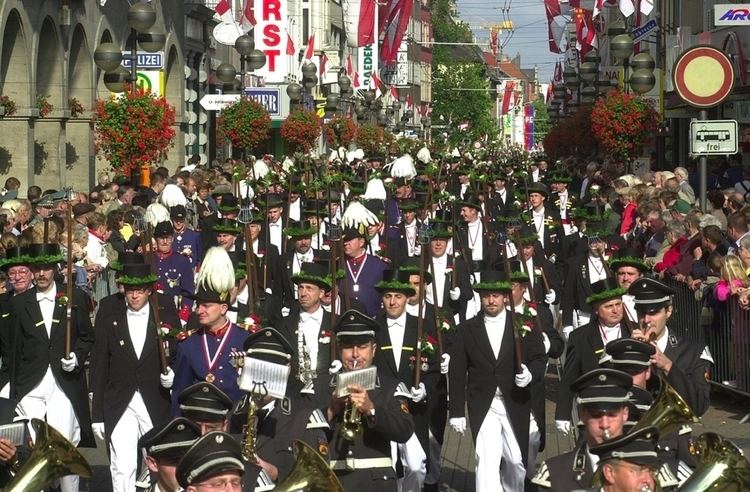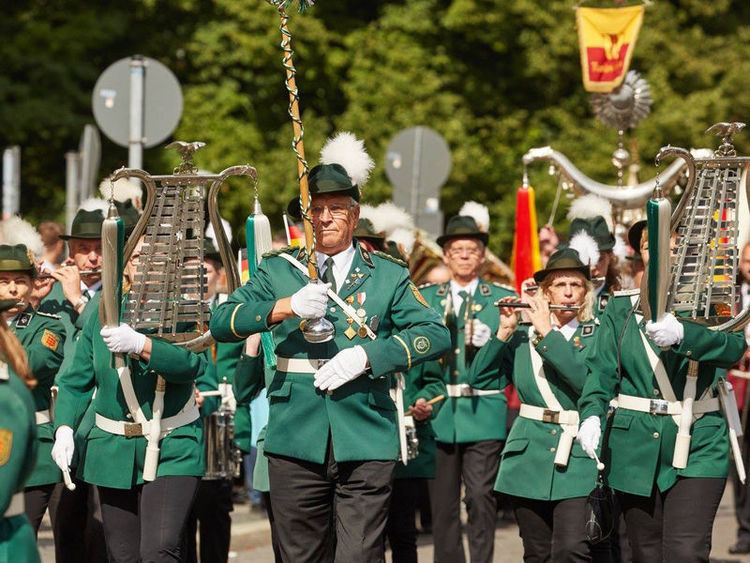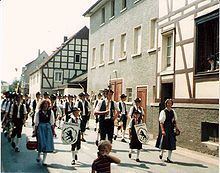 | ||
Der parademarsch beim sch tzenfest 2016 in geseke
A Schützenfest ( [ˈʃʏtsn̩ˌfɛst], marksmen's festival) is a traditional festival or fair featuring a target shooting competition in the cultures of both Germany and Switzerland.
Contents
- Der parademarsch beim sch tzenfest 2016 in geseke
- Dietmar wischmeyer das schu tzenfest m4v
- Medals and decorations
- History
- Germany
- Switzerland
- Overseas
- Australia
- Brazil
- Namibia
- United States
- References

At a Schützenfest, contestants compete based on their shooting abilities, for example by shooting at a wooden representation of an eagle. The winner of the competition becomes the Schützenkönig ("king of marksmen") until the next year's competition.

The commercially-organized Schützenfest of Hanover, Germany, is the largest marksmen's funfair in the world with more than 5,000 marksmen, 250 rides and inns, 5 large beer tents and the "Marksmen's Parade". The parade with more than 10,000 participants from Germany and all over the world and more than 100 bands is 12 kilometres long. It is the longest parade in the world. The landmark of the funfair is the highest transportable Ferris wheel in the world. It is 60 metres high and can transport 420 people in 42 cabins.

Dietmar wischmeyer das schu tzenfest m4v
Medals and decorations

Shooting competitions are a way of life in the Germanic regions of Europe, especially in Switzerland. The initial Swiss Federal Shooting Festival (Eidgenössisches Schützenfest) was held in 1824. Federal contests along with cantonal level, city, and club competitions have continued through to the present day.
Various awards for marksmanship have been won by the competitors. Shooting medals and shooting cups are the most common forms of award. Books illustrating and listing these awards have been published in Switzerland.
Swiss shooting medals were struck in a variety of metals including gold, silver, bronze, white metal and aluminum, with silver being the most common. Mintages are very low with the average mintage of the 45mm silver being 700-800 pieces. The scarcity of medals has increased over the years due to the awards being melted for bullion, being lost, and general attrition. The size of most medals range from 23 millimeters to 62 millimeters with 45 mm being the most prevalent.
Also minted to commemorate the Shooting Festival were shooting thalers. Swiss shooting thalers began mintage in 1842, and continue being minted today. They can be distinguished from shooting medals by their uniform size and temporary legal tender status.
History
During the Middle Ages, many towns had to find ways to defend themselves from gangs of marauders. For this reason clubs and associations were founded, comparable to militias; these paramilitary associations were sanctioned for the first time in the Law for the Defensive Constitution of the Towns by King Henry I, and officially integrated into the towns' defense plans. Accompanying the military exercises and physical examinations of the towns' contingents, festivities were held combined with festive processions. Participants from other parishes and at times even the feudal heads of state were also invited to these Marksmen's Courts (Schützenhöfe). However, the self-confident spirit of the townsfolk that marked these festivities was not always regarded positively by the authorities. For this reason, different traditions developed in different regions. The military significance lessened over the course of the centuries and became meaningless with the creation of regular troops and garrisons for national defence. The Schützenfests however continued in the form of a regional patriotic tradition.
Germany
Schützenfests are celebrated mainly in Bavaria and Lower Saxony, but also in the Lower Rhine and Middle Rhine regions as well as in Westphalia (especially the Sauerland), with festive processions. Since German Reunification, Schützenfests have begun to emerge in eastern parts of Germany as well. The traditions connected to the Schützenfest can vary greatly from one region to another in Germany.
These traditions include the "Blow of the Flag" (a particular way of waving a flag). The Blow of the Flag in particular, as well as the waving of the flag in general are executed according to fixed rules. Competitions are held in the discipline of flag waving.
Schützenfests may range from one day to several days and may include and be accompanied by various events. They often take place in the festival room of a local public house or in a pavilion especially erected for the occasion. In the Sauerland, many towns have a special Marksmen's Hall that is used for these festivities. Many Schützenfests start with a festive procession, whereby the reigning King of Marksmen, along with the royal household, plus local dignitaries, are all escorted by the marksmen and paraded to the festive square or the festivities. This is often followed by a "royal parade" where the marksmen march past the king and the royal court, with marching bands, Corps of Drums and fanfare bands playing along. (Goose steps are commonly done by the marksmen in the parade, especially in old towns and cities, but in other places it is not done, however, as the marksmen march in the same pace as the Bundeswehr do today.) The parading marksmen are formed in platoons or squads depending on the size of the formation, and in large towns and cities marksmen are formed in companies and in both cases of the parade color guards march along with them. In a lot of cases, the pavilion is surrounded by a funfair.
The most common form of shooting competition is the Bird Shooting. Nowadays the contestants no longer shoot at actual birds but on a mock bird made of wood and mounted on a pole. The contestant who demounts the last pieces of the wooden bird is the new King of Marksmen. Varying traditions may include the shooting of wooden animals other than birds or special awards won by the shooting of certain body parts, e.g. wings, beak etc.
Even a Großer Zapfenstreich and band concerts form part of the celebrations as well. The Großer Zapfenstreich done in these civil events, even through military in origin as the festival itself, are formed up of the marksmen's organizations, torch bearers, color guards and a marching band and corps of drums, with an optional fanfare band when needed. Most are done outdoors, and there's an option to have an indoor ceremony done in the same manner as the outdoor ceremony. Many of the groups that help organize these festivities appeal to mostly right wing Germans as this is one of the very few occasions to march in a uniform in public and celebrate German nationalistic feelings, as well as local community and state traditions, thus the use of the goose step, Prussian style weapon drills (sans bayonets) and the wearing of Imperial German military uniforms plus the use of the military hand salute in many of these events (although in several places and/or sharpshooter groups on parade the goose step is not performed and the Bundeswehr marching practice is observed and only one riflemen's association does the high step in the parade in Ahrweller) even as modern styled marching bands or even bands modeled on foreign militaries march along during the parades with different variants per region, in Neuss for example the 1st Marines Tribute Band, based on the bands of the United States Marine Corps, and the Quirinus Band and Bugle Corps, (Bandmaster Peter Hosking Ex Light Division)Germany's 1st ever band and bugles in the traditions of the British Army Light Division regiments (now The Rifles), that were based in West Germany during the Cold War years, have been a part of the parades there in recent years. A few corps save only the use of the US style hand-over-the heart civil salute during the Großer Zapfenstreich itself to distinguish these associations from the Bundeswehr which uses the military hand salute.
Notable German Schützenfests include
Switzerland
Schützenfests played a central role in the Old Swiss Confederacy, during the 15th century, participants shooting the crossbow, contributing significantly to the coherence between the individual cantons. The Schützenfest of 1849 in Aarau figures prominently in Gottfried Kellers Das Fähnlein der sieben Aufrechten, where Keller portrays the shooting clubs as vital for the preservation of direct democracy in the young Swiss federal state. Today a Swiss Federal Schützenfest counts 50'000 marksmen during 4 weeks.
Eidgenössische (federal) Schützenfest are organized by the Schweizerischer Schützenverein since 1824.
Overseas
Schützenfeste organized by German or Swiss expatriate communities overseas:
